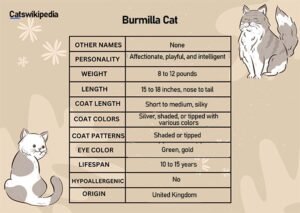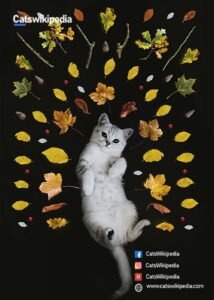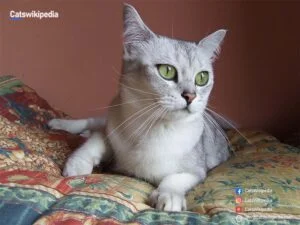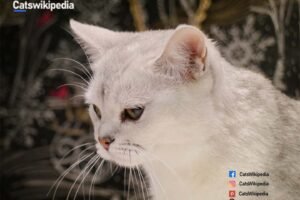Burmilla
Burmilla cat: An Introduction
Burmilla cat is a breed between chinchilla Persians and Burmese cats. These cats are a playful species of a friendly nature that loves their family. Read on and know the sensations of living with a Burmilla cat. They are calm, loving, and friendly. These beautiful cats, a hybrid combination of the chinchilla-colored Persian and Burmese cats, manifest extroverted personalities though laid back.

This breed is identified by its super-soft coat and beautiful green eyes. Burmilla’s are easy-going cats who get along with everybody, making them the perfect first pets and family cats. They first appeared in the 1980s and is still rather rare now. As a result of their rarity and complicated four-generation breeding procedure, Burmilla kittens usually cost between $800 and $1200 from a reputable breeder.
History
The breed was first introduced in the United Kingdom according to the Cat Fanciers’ Association. The breed did not develop as an intended one: it happened due to accidental breeding-an accidental cross between a chinchilla Persian and a Burmese cat. Upon seeing the subsequent litter of kittens with their stunning, thick coats and kind personalities, the Baroness Miranda Von Kirchberg, who owned the chinchilla cat and Burmese parents, was immediately enamored of the new breed.
Following the surprise discovery of the Burmilla-named after the Burmese and chinchilla-the breed now made efforts to keep and expand the breed. Recognizing the breed is very new, breeding organizations have only recently recognized the breed as it is still rather scarce.

General Appearance
They have a very attractive look, soft fur, and muscular, medium-sized, strong, and sturdy bodies. Their weight ranges between 6 and 13 pounds, and males are known to be more heavily weighted than females.
The distinguishing marks for these cats are shiny and silky coats, with black rims on their eyes and nose. A dark eyeliner-like finish gives these kitties the illusion of being ready for a night out that is spectacle. Stunning felines also boast bright green eyes that can get darker with age.
There are two types of coats-long or short in length and in silver, black, blue, brown, cream, lilac, red, tortoiseshell, or point patterns. Although there are many different colours over their coats, they have come to be known for their shiny, silver-tipped coat. The fur is considered to shed quite low, so they do require regular brushing, once a week, on average.
Temperament
A combination of the aggressive, demanding Burmese personality and the peaceful, tolerant Persian temperament, the Burmilla exudes an outgoing, easy-going nature. They are pleasant, participating, and not clingy.

This social breed loves the presence of humans and family. In general, this breed tolerates youngsters, other cats, and other cat-friendly canines. Despite all its sociability, the breed requires some independence and does not need constant entertainment from humans or other playmates.
Generally, the Burmilla is a sweet, friendly companion. The cats like to lounge on your lap and remain playful until maturity.
Life Needs
Burmillas like to play and have fun with their people. As this is such an intelligent breed, they love contact and attention. They will never meow to keep you busy but want so much love. A perfect cat owner or family needs to be ready to play regularly, have one-on-one play with their cat. This is a very flexible breed that will get along with nearly everyone-dogs, other cats, strangers, and even children.
Because it loves attention does not mean the breed is needy. Instead, it needs time alone. Allow your cat to have some space of her own at times. But please do this only with a limited amount of space as these cats may get bored and anxious with the extensive exposure to leaving them alone. The ideal setting for a Burmilla is a quiet, predictable household with frequent human company.
Even though burmillas are essentially indoor cats, they might love venturing out into the great outdoors on a leash. Keep your cat indoors where it will keep cool during the summer months because these cats are sensitive to heat.
They may be clumsy, but they love to climb and conquer. The cluttered bric-a-brac and rickety shelves will only endure for a little while when this breed is around. To make your cat a happy cat, provide her with some lofty cat trees, shelves, and hammocks up high to climb and sleep in.
Care
Grooming a cat should be pretty simple, whether she is long-haired or short. Both coat lengths may mat up, though a weekly brushing should be enough to loosen any significant tangles or knots. A good tool to use is a stainless steel comb. These cats also require regular nail trims, ear cleanings, and dental checkups.
The Burmilla conforms to the same exercise routine of most other cat breeds, following surges of energetic play with extended periods of napping. Cat trees, toys, and one-on-one play will keep your pet active.
This clever breed is easy to train and will easily find pleasure in it. Bring them to scratching posts and litter boxes will be a simple process.
Socialization at an early stage, done gently, makes your cat feel comfortable and safe. Once these cats are properly introduced to other people and pets as well, then they become friendly and interactive.
They need to be fed with high-quality cat food according to their veterinarian’s prescription. This breed may easily get fat, so feed them in moderation.
Health
These cats tend to be healthy, but they live a long life span of 7 to 12 years. However, they also face certain health issues-the main ones are allergies and kidney disorders.

“The Burmilla is prone to the development of polycystic kidney disease as they grow older,” said Venator. “Which in turn can result in cysts in their kidneys, which may eventually cause kidney failure.”
Responsible breeders may screen kittens for health problems, however, it is crucial to continue monitoring your cat with a veterinarian and follow the veterinarian’s advice.
Fun Facts
1-The Cat Fanciers Association only recently established this as a recognized breed.
2-It was by accident that these cats were developed. The chinchilla Persian stud who bred this small litter nearly lost the opportunity because he was nearly neutered; otherwise, he would have never accidentally mated with the Burmese mommy cat.
3- “Full Burmillas” require four generations of breeding, where each litter’s offspring bred onto the Burmese until the desired breed standard is reached.





